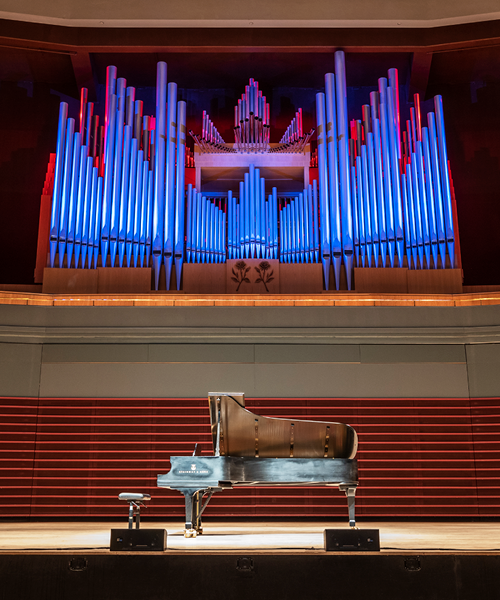
Subscribe to our

A Midsummer Pipe's Dream
Learn about how the Carthy Organ in the Jack Singer Concert Hall at Werklund Centre is cleaned.
Dena Vahle, Aug 22, 2025, Werklund Centre
It's August in Calgary, and the Jack Singer Concert Hall is unusually quiet. Where we usually hear vibrant music, lively performances, and chattering patrons, there is an acute silence.
Though the beloved concert hall might seem abandoned at first glance, it's secretly bustling with activity. Hidden behind clear plastic sheets and caution tape, experts, musicians, and Werklund Centre (formerly Arts Commons) employees work together to meticulously clean and dismantle parts of the magnificent Carthy Organ for the first time in 38 years.
You might be wondering, "Don't they ever clean it?" Rest assured, the organ is regularly dusted and maintained. However, many parts are completely inaccessible during daily operations, which is why experts Steve Miller, an organ tuner and technician, and Chellan Hoffmann, the National President of the Royal Canadian College of Organists, have been brought in for this extensive project. 
Photo: Dena Vahle
But let's rewind a bit. Built in the Casavant factory over the course of 15 months, the $750,000 Carthy Organ was a donation by the Carthy Foundation in memory of Margaret Mannix. After being carefully dismantled and shipped to Calgary, it took an additional five months to install, voice, and tune. Inaugurated in 1987, the organ is housed in a hand-carved, solid oak structure with a large acoustical canopy suspended above it. It's an imposing instrument, featuring 6,040 pipes, 75 stops, 111 ranks, four manuals, and a pedal.


Construction of the Jack Singer Concert Hall, August 13, 1984.


Fast forward to 2025. After thousands of concerts and countless performances, it's time to give the organ some much-needed love and attention so future generations can continue to enjoy its magic. But what, exactly, makes this undertaking so special? To investigate that question, Steve took me on a little tour inside the organ –– and I promise you, it's not for the faint of heart. After climbing over wooden structures, ducking under metal components, and carefully navigating a wobbly ladder and thin baseboards, we arrived at the very heart of the instrument.
Standing there, awe-struck, surrounded by the inner workings of this massive instrument, I finally realized the complexity of the project. Where empty slots for pipes remained, the truth of the situation set in: How could anyone possibly clean this with all the pipes in place during a full season? As I gazed out at the one-of-a-kind view of the Jack Singer Concert Hall, completely mesmerized by the craftsmanship, Steve gave me a deep dive into the organ's inner workings.

Carthy Organ cleaning, August 2025. Photo by Dena Vahle



So, what makes this cleaning so complex? After squeezing through just the beginning of the intricate space, it was painfully obvious how difficult this job is. To access certain areas, pipes must be removed to reach the ones further back. If certain pipes require extra work, they are completely removed from the organ, washed, cleaned, and polished before being returned to their unique slots after the space has been thoroughly vacuumed. Everything in the more accessible front sections is in excellent condition, so those pipes are not touched this time around.
In addition to the pipes, the entire inner mechanism is also dusted and vacuumed. To ensure each pipe is returned to its correct location, we rely on the identifying stamp embossed in its metal. These stamps specify the pipe's family—such as Trumpet, Clarion, Trompette, or Bombarde—along with its height and the musical note it plays.
Why do the pipes and the organ need to be cleaned in the first place? The short answer: dust. The longer answer: over the years, just like in your home, dust settles into all the nooks and crannies, including inside the pipes themselves. This buildup can effectively change how the pipes perform and sound. The vibrations change, which in turn alters the sound, making it muffled, distorted, or –– in the worst-case scenario –– completely silent. The good news is the organ does a great job of keeping itself clean, especially when it is used in concerts and through the regular cleanings completed throughout the year.
Once the cleaning is complete, the job is still far from over. All of those newly cleaned and polished pipes will need to be tuned—a massive undertaking in itself. It will take roughly a week just to tune the newly cleaned sections. The team expects to wrap up the project by the end of August, just in time for the Calgary Philharmonic to return and begin rehearsals for the upcoming season.










In addition to Steve, Chellan, and the Werklund Centre staff, the project also had help from three young organ students: Victoria Mogileyskava, Ashley Tenbrinke, and Xander Zuk. Seeing young people involved in organ music and its maintenance makes the future of this magnificent instrument — and the music it creates — look incredibly bright.
Header image: the Carthy Organ in the Jack Singer Concert Hall with piano on stage. Photo by Will Young

Dena is the Social Media Coordinator for Werklund Centre, where she's often found capturing the behind-the-scenes magic with her phone—especially when her furry office friends are involved! Outside of work, her passions lead her to the rugged beauty of the backcountry, where she photographs mountain ranges, glacier lakes, and adventurous friends.





